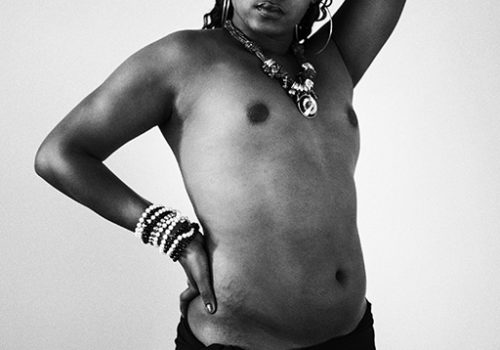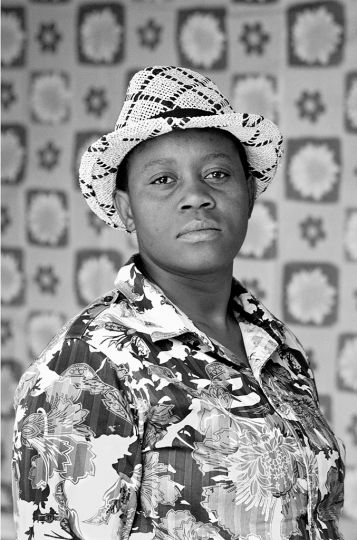Liverpool’s Open Eye Gallery showcases the first major exhibition in the UK for South African photographer and visual activist Zanele Muholi. Muholi has exhibited her work of black lesbian and LGBTI South Africans for more than a decade and has achieved international recognition by producing a visual history which keeps visible the faces, bodies and lives of a community living with homophobic violence and discrimination.An other photographer might focus a little too much on the sensational subjects of rape and murder that affects a community, but in Muholi’s hands there is a determination to show the whole picture. In doing so, her audience is witness to a very personal connection between photographer and participant with gorgeous images of dignity, defiance and celebration of black lesbians and LGBTI.
I interviewed Zanele at Open Eye Gallery before the opening of Vukani/Rise where I was also introduced to two of her participants, Lerato Dumse and Somizy Sincwala.
Ginger Liu: What is the meaning behind Vukani/Rise?
Zanele Muholi: Vukani is a Zulu word meaning rise. It calls upon every second LGBTI person to rise above whatever circumstance that person might be going through, especially at the height of different phobias because fear is two way. Either the person who is a homophobe is in fear of the unknown or it is us having to live in fear of not knowing what might happen where or when. It is a call for action and to say never allow any circumstances to pull you down. Just rise beyond, no matter what.
GL: You have a special relationship with your subjects, many of whom you return to photograph year after year. How has this grown and developed over the years?
ZM: I don’t work with subjects, I work with participants. I’m very specific with that. People who are in my photographs participate in an ongoing project. I want to connect and also that connection has to be consented to do it with respect. And to make sure that we fully understand that whatever you are doing at a particular time, you are standing there and you are writing a history or you are a history maker. The fact that you say you are, not everyone is as brave as you, which is why I say it is participation. That act, your action, your involvement, your intervention may lead to another person being liberated or being educated around the same issues that affect us.
GL: Twenty years ago did you ever expect that you would be a visual voice for the lesbian and LGBTI community?
ZM: I’ve been around for some time and you saw the low quality documentary that shows events that took place more than ten years ago. So twenty years ago I was still there and even though I said things differently, I was clear with my plan. Obviously my work was not as known as much as now. I was studying public relations and I wanted to do something else. I wanted to focus on film and documentaries. But now I’ve found a personal and positive approach to this visual activism and I’ve managed to break through. People are listening. Others are thinking art activism or visual activism is key. I knew I wanted to be somewhere. I knew I wanted to travel. How it was going to happen, I didn’t know at that time.
GL: Explain how the Faces and Phases project began and what you wish to convey with these set of images?
ZM: Faces and Phases began in 2006. Prior to them I started shooting portraits of different individuals who were close to me. In 2006, I lost a friend who was a HIV activist and poet and also a lesbian mother. And as I was still trying to process that, my nephew committed suicide . My other friend who was also an HIV activist, poet, writer, a spokesperson for hate crimes and a “corrective” rape survivor also succumbed to HIV complications. Those were three major losses that happened in a short space of time. It was then that I thought that we needed positive images that could speak today and in which we remember the people that we loved and treasured and contributed so much to our lives. I just need to have these positive images of these beautiful beings occupying the same space as me and be remembered.
GL: How do your participants react when they see themselves over a period of time?
ZM: There are different reactions because you can see when a person was young. And the reaction is never the same because you see how beautiful some of them look right now and you see so much change because we grow up as individuals.
GL: And of course, only they know what they were thinking at the time.
ZM: We request people to write their stories and also to ask basic questions of how they are doing now and why they agreed to participate.
GL: You seem to favor black and white photography in your practice.
ZM: I was taught photography in black and white so I know how to shoot, develop and fix. My early work is in black and white which is partly currently on show at Liverpool Tate. I needed to have that timeless feel of our lives being there before I was born. If you had black LGBTI individuals in the 1950s and ’60s, that photography is likely to be captured in black and white because of what was accessible back then. That sepia tonality would have been part of the document and the grain and the stain would have been part of the document. I like black and white. It’s a more classic and timeless feel that represents something that was, that existed before. Whereas color is present and it could be anything and any time.
GL: Being visible is a common theme in your work. Why is it so important for the LGBTI community to be seen and heard in South Africa?
ZM: In South Africa and Beyond. We don’t see many black faces at galleries abroad and in museums. People either have objects in different spaces that speaks to a different past. We don’t see much. That’s the whole point of making the invisible visible because we are part and parcel of whatever is happening in different spaces. So we as LGBTI people owe it ourselves to make sure that we are seen because to be seen means that we are recognized and recognition means that we are being respected and being respected means that our voices are heard. It’s not about flaunting the queerness or to exoticize the black gay man and black body. It is beyond just that.
It’s time that we see ourselves positively and also in a manner that makes us feel whole and safe and sensible. Those voices connect and keep you going because you know that you are not alone. Before being lovers we come from families. We are born by men and women and I think that these are the documents that are lacking in the mainstream archive right now. Let us bring these voices and visuals to the fore. Bring them forward into the gallery spaces. We can’t limit it to our spaces and say this is only a LGBTI group. I don’t want to be projected in a limited space. I want to mainstream our issues so people understand and have some education around LGBTI people from home and beyond. I want to be remembered as a human being before my sexuality is fed into me. I want my work and the work featuring those that I respect, to be recognized beyond just naming.
So it’s very political. I wish that LGBTI people and the mainstream society get the opportunity to see and ask questions and also to wonder where are your own people and why this work is here because each and every individual comes from somewhere. And each and every individual has their own life story to tell beyond just the body that is projected in your face. I want to make sure that we have a visual history that speaks to us and to the current generation and will inform future generations because the past is not easy to touch.
GL: The After Tears project is a moving collection of portraits depicting the “Mo(u)rning” of gay activist Muntu Masombuka. Explain the image process and the impact these images have had.
ZM: These are very enacted scenes where we had a night vigil remembering those that came before us who are no longer here. And it features individuals who are in Brave Beauties 2013-2014. So I needed to remember. You know, remembering again? Also having a memory and memorizing. And it’s simplified because you can tell in their faces that something has happened but you don’t know until you are told they are enacted scenes. And I could relate to one major case in which I could see how death connects LGBTI individuals when somebody has passed and then we don’t even need to wait for invitations to come to funeral, it becomes automatic for us to be there and make sure that we mourn with the family. And we are basically saying, we remember you, we remember you.
GL: Zava is a very personal group of images of you and your girlfriend. Is this something you intend to develop in the future?
ZM: Like all my projects, Zava is continuous but it is really deeply personal. I’m in a long distance relationship so I don’t get to see my girlfriend every day because we are both busy and live in faraway places. She lives in Paris. So the two to three minutes that we get to be together, that’s when I really feel the beats that once again I’m with her. We’ve been working on this project tirelessly for the past three years and she is really someone that I love and I’m not posing with a model. This is me and her and that’s how I like to remember.
The interview was published by http://ragazine.cc. Ginger Liu is a photographer, writer/editor and filmmaker based in Los Angeles and London. www.photo.gingerliu.com
@gingerliu
INFORMATION
Zanele Muholi: Vukani/Rise
Exhibition closed
Open Eye Gallery
19 Mann Island
Liverpool Waterfront
Liverpool L3 1BP
United Kingdom
+44 (0) 151 236 6768
http://www.openeye.org.uk
http://inkanyiso.org

















